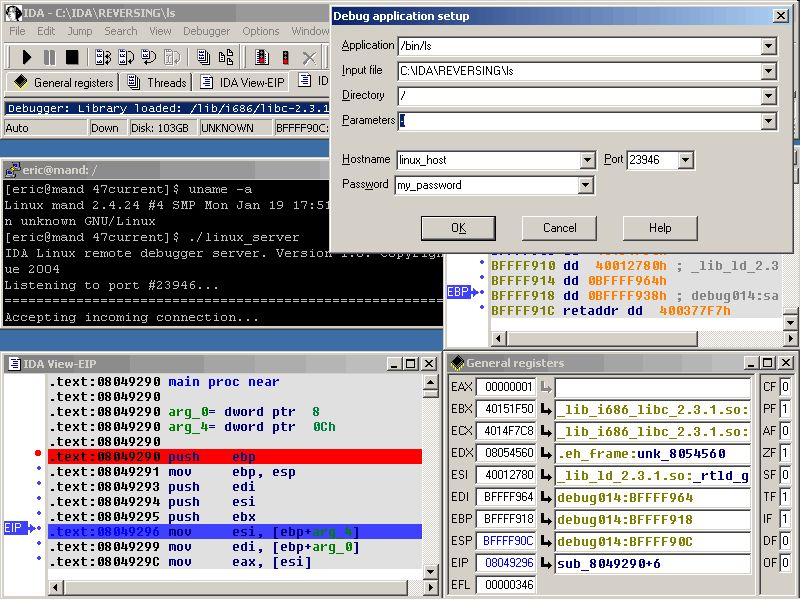

- #Linux disassembler debugger how to
- #Linux disassembler debugger software
- #Linux disassembler debugger code
- #Linux disassembler debugger password
#Linux disassembler debugger password
Then we can manipulate the results of EAX or the JNZ command to always take the path to the correct password message. All is not lost, we can use IDA’s debugger to step to this crucial decision point: But suppose we did not see the passphrase, perhaps it was obfuscated or encrypted, or buried in thousands of thousands of lines of code. We can test that by running crackMe from the command line and typing in “ericroolz” and we should get the “Correct password” message.

Just by static examination, we managed to extract the passphrase. It looks like this comparison routine is comparing the user’s command line input to the hard-coded string “ericroolz”. Note the hard-coded string that is moved into the ECX register: Scrolling down a little ways, we see what looks to be a command prompt asking for the passphrase and then some sort of comparison routine. So we will have to deal with this common anti-debugging technique. If we were to start the IDA debugger (green arrow button or hit F9 key), crackMe simply exits. It sets EAX to 0 if the calling process is not being debugged. It sets EAX to 1 if the calling process is being debugged. crackMe, is being debugged by a user-mode debugger. According to the Microsoft Developers Network documentation, this function determines if the calling process, i.e. Right at the start, we can see a call being made to a Windows API, IsDebuggerPresent.
#Linux disassembler debugger code
Once the debugger is set, the green debugging arrow should be activated.īefore we begin debugging, lets navigate around the code to find some interesting landmarks. In the menu bar, select Debugger, then at the dialog box, select the Local Win32 debugger. The space bar will toggle back and forth between call graph view and flat view.īefore examining the source code, let us first set up IDA’s debugger.


You can change from this call graph view to a flat source code view by hitting the space bar. The middle window contains a call graph of the entire binary. Both can be used to quickly navigate to areas of code that might be interesting to investigate. The boxes on the left side contain a function window and a graph overview window. the C run time library), and the pink area refers to Windows APIs that are loaded by Dynamic Link Libraries (DLLs). The light blue bands refer to functions that come from a library (e.g. The dark blue bands refer to code or functions written inside the binary. It gives a layout of the binary as loaded in the virtual address space of memory. You should see a window similar to the screenshot below:Īt the very top is the navigation band. IDA will ask if you want to switch to “proximity view now”, simply click the “No” button. Then click Ok on the “Load New File” Window: Select the “New” button and then open your crackMe binary: Double-click to the IDA demo icon and you should see a window like below: With just a debugger and a disassembler, we can often extract keys and learn a lot about the our target software.Īfter installing your IDA demo.
#Linux disassembler debugger software
This is the power of reverse engineering and using tools such as IDA Pro’s disassembler and debugger: we don’t need the source code to learn how the software works. Since we don’t know the correct passcode, the software exits with a “wrong password” message. In our scenario, we have a piece of software that is asking for a passphrase or key to unlock it. Simply unzip, load into IDA Pro, and follow along.Īfter unzipping the target binary and running it
#Linux disassembler debugger how to
In this post, we will learn how to use the demo version of IDA Pro to disassemble, debug, and crack a simple crackMe software.


 0 kommentar(er)
0 kommentar(er)
